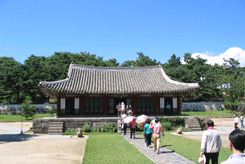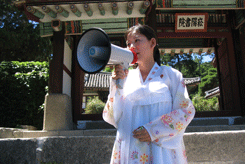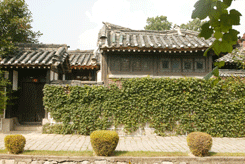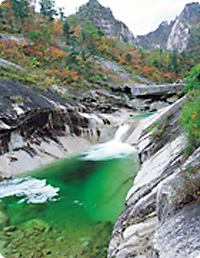GAESEONG
 |
 |
 |
Gaeseong Namdaemun
Kaesong Namdaemun which was built in the early Joseon dynasty (1392-1910), served as the south gate of the ancient palace. The gate was destroyed during the Korean War (1950-1953), but reconstructed in 1954 soon after the war. Standing majestically in center of Gaeseong, the gate represents humble architectural design from Goryeo dynasty (918-1392). Today, the gate holds 14 ton of Buddhist bell called Yeonboksajong, which was moved from Yeonboksa (temple).
Seonjukgyo
Seonjukgyo is a stone bridge which has length of 6.67 meter and with of 2.54 meter. Being one of the highlight spots of Gaeseong, the bridge has become more famous with assassination of loyalist Jung Mongju in 1392. First called Seonjigyo, but later renamed it as Seonjukgyo for the bamboo grew by the bridge after this political assassination.
Bakyeon waterfall
Bakyeon waterfall is one of most beautiful waterfalls in Korea along with Guryong waterfall in Geumgasan and Daeseung waterfall in Seoraksan. The 37 meter high waterfall cascades from the valley of Cheonmasan and Seongeosan with a thunderous roar. The waterfall cascades down into the pond called Gomodam.
Tomb of King Wanggeon
The entombed are Wanggeon, the founder of Goryeo dynasty (918-1392) and his queen consort. First constructed in 943, the tomb has been moved several times during the foreign aggressions that devastated the kingdom from the 11th to the 13th century. The tomb was rebuilt here in 1276, but it is not yet confirmed that present location is the original site. The tomb once experienced a grave robbery in 1906, and was destroyed during the Korean War. An excavation was carried out in 1992. The tomb was fixed and stele was erected. Twelve protection stone panels with zodiac designs were collected, but now entombed for protection reason. Murals were painted in four directions with plum, bamboo, pine, tiger, turtle and 8 stars on the ceiling.
Tomb of King Gongmin
Located 17km west of Gaeseong, the tomb is one of the most representative Goryeo tombs built after Fungsui idea. Gongmin was the 31st ruler of Goryeo dynasty (918-1392) who loved painting and drawing. Upon his beloved queen’s death in 1365, he concentrated in tomb building, and personally designed and directed the construction for 7 years. He died two years later in 1374. King Gongmin is buried on the left and queen on his right. This 6.5 meter high tomb mound is protected at the lower parts with 12 protection stone panels with zodiac and lotus designs.
Yeongtongsa
Built in 1027, the temple had close relationship with Goryeo royal court. Situated 8km east of Gaeseong, the temple is a birthplace of Cheontae Sect, a school of the celestial platform. It was founded by Icheon, the fourth son of the 11th ruler of Munjong, who stayed in this temple until his death in 1101. The temple left unattended until recently, but it was restored in 2005. The temple boasts of many cultural assets like temple banner pole support, three storied stone pagodas, and five storied stone pagoda. In addition, the temple holds graceful architectures including main hall, gates, belfry, lecture hall and small buildings holding stele and stupa.
Goryeo Museum
Goryeo Museum displays well over 1,000 historic and cultural assets including scores of the famous celadon porcelains, metal types, metal weapons and armor in its four exhibition halls. Displayed outdoor includes Buddhist pagodas.
Kaeseong (Gaeseong) Industrial complex
The Kaeseong Industrial Complex is located inside North Korea just across the demilitarized zone from South Korea. It is an industrial park and duty-free trade facility established as a joint venture between the South and North Korean governments to allow South Korean companies to manufacture goods in the North. Financed and managed for the most part by South Korea, the project was launched in 2004, and South Korean companies could manufacture their products using North Korean labour. It argued that would help North Korea start to reform its economy, which is in a dire state, and ease tensions between the two Koreas. Companies have been given incentives by the South Korean government to move operations there, including political risk insurance to cover losses in their investment, and all the goods made there are exported to South Korea for sale.
The complex has been a gauge of the volatile security situation on the peninsula, the last flashpoint of the Cold War era where hundreds of thousands of troops face each other across the border. Operations in the zone, for example, nearly stopped late 2006 in the wake of a nuclear test by Pyongyang. Since the Feb. 13, 2006 denuclearization agreement, however, businesses have gone back to normal. Currently, more than 124 firms are producing clothes, shoes, watches and kitchen utensils there, employing 803 South Korean and 54,764 North Korean workers since the first products came out in December 2004. This jointly run Industrial complex is totally shutdown as of February 10, 2016 in response to North Korea’s recent nuclear test and satellite launch.






